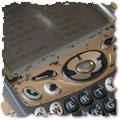Obviously there’s the whole thing about the Palm Pre versus the iPhone, but Palm has had a tradition of following Apple’s moves, even ignoring the direct comparisons between the Palm Pilot and the Apple Newton.
| Apple | Palm/PalmSource |
|---|---|
| Licensed its operating system to other hardware manufacturers, which hurt the platform in the long-run. | Licensed its operating system to other hardware manufacturers, which hurt the platform in the long-run. |
| CodeWarrior-based development environment for 68K applications. | CodeWarrior-based development environment for 68K applications. |
| Underwent a hardware transition from Motorola 68K to PowerPC to Intel, going from a big-endian architecture to a little-endian one. | Underwent a hardware transition from Motorola 68K to ARM, going from a big-endian architecture to a little-endian one. |
| Transitioned from 68K to PowerPC with System 7, which used an emulation layer to run old 68K applications. Much of the operating system was PowerPC-native, but portions (especially user applications) were still 68K-based. | Transitioned from 68K to ARM with Palm OS 5, which used an emulation layer to run old 68K applications. Most of the operating system was ARM-native, but it did not officially support fully ARM-native user applications (with some exceptions). |
| Attempted to replace its traditional operating system with a modern, fully PowerPC-native one (Copland) but failed. | Attempted to replace its traditional operating system with a modern, fully ARM-native one (Cobalt) but failed. |
| Considered acquiring Be to use BeOS as its modern operating system. | Actually acquired Be and used portions of BeOS in Cobalt. |
| Its modern operating system, Mac OS X, is based on the Unix operating system. | Palm’s modern operating systems, webOS, is based on Linux, a Unix-like operating system. PalmSource’s modern operating system, ALP, also is based on Linux. |
It’s a shame that Cobalt was stillborn; I think an upgraded version of Palm OS would have been exactly what I wanted. (ALP could be it, but it still hasn’t shipped on any actual devices, and being so late to the party, I suspect it might end up suffering the same fate as Cobalt.)


